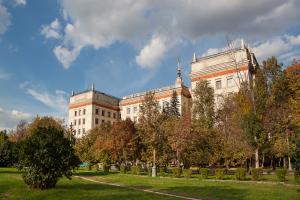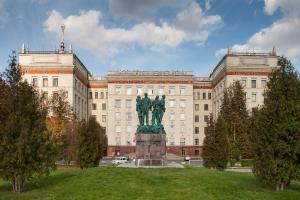 Research Institute of Nuclear Physics, Moscow State University was founded February 1, 1946 its founder and first director DV . Skobeltsyn. At the request of the Scientific Council of SINP in 1993 by the Academic Council of Nuclear Physics of Moscow State University was named after D. Skobel'tsyn.
Research Institute of Nuclear Physics, Moscow State University was founded February 1, 1946 its founder and first director DV . Skobeltsyn. At the request of the Scientific Council of SINP in 1993 by the Academic Council of Nuclear Physics of Moscow State University was named after D. Skobel'tsyn.
After the war, the country started to work on the problems of nuclear power. Abruptly began to be felt a shortage of specialists to deal with the most important scientific and applied problems. In order to train personnel for the developed-country nuclear science and technology special government decree in early 1946 in Moscow State University organized the 2nd Physics Research Institute (later renamed the SINP) and separation of the Structure of Matter Physics Department of Moscow State University (later the Division of Nuclear Physics of the Physics Department of Moscow State University).
After creating the INP and OYAF began training for research on the physics of uranium fission and thermonuclear fusion reactions. DV Skobeltsyn instructs lecturer SS Vasilyev organizing laboratory of nuclear reactions with a small 72-cm cyclotron. In record time were osuschestlena design, manufacture and installation of the cyclotron and in 1949 it was launched. It was the first in higher education in the country cyclotron, which are now held and applied nuclear physics and the study of ion-atom collisions.
DV Skobeltsyn paid attention to experimental research in nuclear physics, not only in the laboratory of nuclear reactions, but also in other laboratories, which initially headed by Academician IM Frank and Professor L. Groshev, is both head of department. For the management of departments and lectures in the Department were involved in the greatest scientists: chl.korr. DI Blokhintsev Academicians VI Wexler, MA Markov, chl.korr. FL Shapiro.
Thanks to sustained leadership by DV Skobeltsyn and SN Vernov, institutions and implement research it became known and appreciated in the country. Government decision in 1949, the institute was awarded the category of leading research institute.
In 1949, the Government adopted a resolution to construct new buildings of Moscow State University on Lenin Hills. DV Skobeltsyn and SN Vernov seek additional regulations on the construction of special buildings to house a set of accelerators, and special installation for studying extensive air showers.
In a laboratory radio-INP (Head - Academician AM Prokhorov), the main theme of which - the definition of the nuclear moments of stable and radioactive nuclei. OYAF invited to Academician LA Artsimovich to organize the Department of Atomic Physics, Workshop on nuclear physics and research on topics consistent with the work program of the Institute of Atomic Energy.
These years were also marked the start of work on the study of the cosmos with satellites. A decision on the need to connect to the INP training and research on the physics of the cosmos. DV Skobeltsyn and SN Vernov SINP in a group with the task of creating small device to be installed on satellite. Such a device has been manufactured and November 4, 1957 on the first artificial satellite launched into space. This device was made the first measurements of cosmic rays beyond the Earth's atmosphere. In May 1958, the third satellites has been installed more advanced devices. With the help of this equipment has been exposed to the external radiation belt. For the development and further studies of cosmic rays and the Earth's radiation belts at INP established experimental design laboratory, whose efforts in 1958-60. measurements were made on the first lunar automatic stations and prepare a comprehensive experiment to study the radiation belts of the Earth by satellite "Elektron".
Significant scientific achievements of the Institute have been associated with the introduction in the late 50's, the unique setting for the study ultrahigh energy cosmic rays - EAS MSU. With established on the basis of a new method for studying air showers installation was obtained a number of new results and, above all, discovered the famous "kink" in the energy spectrum of primary cosmic rays with an energy of 3 * 1015 eV.
In the late 50's, when they were put into service almost all the major accelerators, EAS, refurbished workshops were open to visit the institute numerous delegations, including those from abroad. DV Skobeltsyn and SN Vernov taken at the Institute Frederic Joliot-Curie, Niels Bohr, Heisenberg, Rossi, Yukawa and many other prominent scientists that contributed to the strengthening of scientific authority and scientific relations INP.
Under the direction of S. Vernov active research on automatic interplanetary station. At all stations en route to the Moon, Mars, Venus, is set for detecting charged particles.
In four series of satellites "Proton" was the first direct experimental materials on the energy spectrum of all particles up to 1015 eV, and the cross section of proton-proton interactions on the energy of 1011 -1012 eV. For nearly 20 years, the data on the energy spectrum and repetition were the starting point for all of the studies of primary particles.
 Soon after the discovery of the radiation belts SN Correctly assess their potential danger to the planned human space flight. Therefore, on his initiative in SINP established team to develop physical methods applicable to space radiometry and dosimetry. The first radiometric equipment was installed at the second spacecraft in 1960 With it obtained the first data on the radiation fields on the slopes of alleged human spaceflight in particular, was the phenomenon of "sagging" of the radiation belts of magnetic anomalies. Of radiation safety first flight followed SN Verne. Subsequently, on his initiative in SINP was established first team, and then laboratory materials in space. A cycle of studies on the development of principles simulate the effects of space radiation and other space factors for various materials and elements. As an example, the study of radiation resistance of silicon solar inverters. Simulation tests carried out at the cyclotron, showed that the main damaging factor for solar cells were Earth's radiation belt protons with an energy of 1.5 MeV.
Soon after the discovery of the radiation belts SN Correctly assess their potential danger to the planned human space flight. Therefore, on his initiative in SINP established team to develop physical methods applicable to space radiometry and dosimetry. The first radiometric equipment was installed at the second spacecraft in 1960 With it obtained the first data on the radiation fields on the slopes of alleged human spaceflight in particular, was the phenomenon of "sagging" of the radiation belts of magnetic anomalies. Of radiation safety first flight followed SN Verne. Subsequently, on his initiative in SINP was established first team, and then laboratory materials in space. A cycle of studies on the development of principles simulate the effects of space radiation and other space factors for various materials and elements. As an example, the study of radiation resistance of silicon solar inverters. Simulation tests carried out at the cyclotron, showed that the main damaging factor for solar cells were Earth's radiation belt protons with an energy of 1.5 MeV.
By the end of the 60s a substantial increase in research conducted by the Institute of Space Physics, the volume contractual and developmental studies. Increased material, financial and human resource capacity of the Institute focused on developing academic work OYAF and INP. Institute creates printing base and together with teachers OYAF annually increasing production of training manuals on special courses for students. To work in workshops increasingly involved members of scientific departments of the Institute.
